Celestial sphere Study guides, Class notes & Summaries
Looking for the best study guides, study notes and summaries about Celestial sphere? On this page you'll find 160 study documents about Celestial sphere.
Page 4 out of 160 results
Sort by
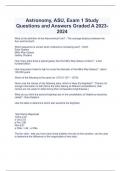
-
Astronomy, ASU, Exam 1 Study Questions and Answers Graded A 2023-2024
- Exam (elaborations) • 10 pages • 2023
-
- $11.49
- + learn more
What is the definition of the Astronomical Unit? - The average distance between the Sun and the Earth Which sequence is correct when ordered by increasing size? - Earth Solar System Milky Way Galaxy Galaxy Clusters How many stars does a typical galaxy like the Milky Way Galaxy contain? - a few hundred billion How long does it take for light to cross the diameter of the Milky Way Galaxy? - about 100,000 years Which of the following is the same as 1.573 X 10⁴? - 15730 Given onl...
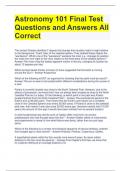
-
Astronomy 101 Final Test Questions and Answers All Correct
- Exam (elaborations) • 7 pages • 2023
- Available in package deal
-
- $13.49
- + learn more
Astronomy 101 Final Test Questions and Answers All Correct The ancient Greeks identified 7 objects that change their location night-to-night relative to the background, "fixed" stars of the celestial sphere. They dubbed these objects the "wanderers". Which one of the "wanderers" wanders the most (i.e., changes its position the most from one night to the next) relative to the fixed stars of the celestial sphere? - Answer-The moon (has the fastest apparent motion in the sky, changing its l...

-
ASTRO 2ND EDITION SHOHINI GHOSE - Test Bank
- Exam (elaborations) • 264 pages • 2023
-
- $22.94
- + learn more
1. Which of the following definitions best describes a constellation? a. a region of the sky containing a certain star pattern b. a group of very bright stars c. a group of very faint stars d. the dividing line between the north and south celestial hemispheres ANSWER: a 2. How many official constellations are there? a. 98 b. 88 c. 13 d. 55 ANSWER: b 3. Which of the following best describes the Big Dipper? a. an asterism b. a faint star near...
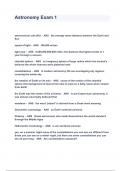
-
Astronomy Exam 1 Questions With Explanations
- Exam (elaborations) • 5 pages • 2023
- Available in package deal
-
- $11.49
- + learn more
Astronomy Exam 1 Questions With Explanations astronomical unit (AU) - ANS the average mean distance between the Earth and Sun speed of light - ANS 186,000 mi/sec light year - ANS 6,000,000,000,000 miles; the distance that lights travels in 1 year through a vacuum celestial sphere - ANS an imaginary sphere of large radius which the ancient's believed the whole heavens were plastered onto constellations - ANS in modern astronomy, 88 non-overlapping sky regions, cove...
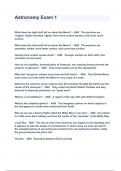
-
Astronomy Exam 1 Questions And Answers
- Exam (elaborations) • 7 pages • 2023
- Available in package deal
-
- $11.49
- + learn more
Astronomy Exam 1 Questions And Answers What does the light stuff tell us about the Moon? - ANS The portions are rougher, higher-elevated, lighter, have more craters present, and cover more surface. What does the dark stuff tell us about the Moon? - ANS The portions are smoother, darker, have fewer craters, and cover less surface. Having more craters means what? - ANS Younger surface on dark stuff; had volcanism at one point. How do rice paddies, domestication of livestock, an...
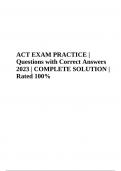
-
ACT EXAM Questions With 100% Correct Answers Latest Updated 2024 (GRADED)
- Exam (elaborations) • 11 pages • 2024
-
- $14.99
- + learn more
ACT EXAM Questions With 100% Correct Answers Latest Updated 2024 (GRADED) acceleration - Answer Change in velocity divided by the time it takes for the change to occur acceleration due to gravity - Answer 9.8 meters per second squared accuracy - Answer A description of how close a measurement is to the true value of the quantity measured. acid - Answer A substance that increases the hydrogen ion concentration of a solution. analysis - Answer A detailed examination of the elements or struct...
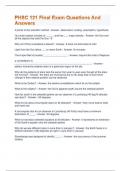
-
PHSC 121 Final Exam Questions And Answers
- Exam (elaborations) • 5 pages • 2024
- Available in package deal
-
- $10.99
- + learn more
PHSC 121 Final Exam Questions And Answers 4 points of the scientific method - Answer -observation, testing, assumption, hypothesis Our solar system consists of ______ and has ___ major planets - Answer -the Sun and all the objects that orbit the Sun / 8 Why isn't Pluto considered a planet? - Answer -It does not dominate its orbit Light from the Sun takes ___ to reach Earth - Answer -8 minutess The Kuiper Belt is located __________________ - Answer -beyond the orbit of Neptune ...
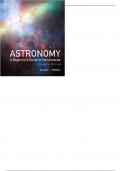
-
Test Bank For Astronomy A Beginners Guide to the Universe 7th edition by Chaisson
- Exam (elaborations) • 413 pages • 2023
-
- $32.78
- + learn more
Chapter 0 Charting the Heavens: The Foundations of Astronomy 1) Right ascension in the sky is very similar to latitude on the Earth. Answer: FALSE Diff: 1 Section Ref.: 0.1 2) Latitude and right ascension are coordinate systems used to find objects on the celestial sphere. Answer: FALSE Diff: 1 Section Ref.: 0.1 3) The celestial sphere is divided into 88 modern constellations. Answer: TRUE Diff: 1 Section Ref.: 0.1 4) In the sky, declination is measured in degrees north or south of th...
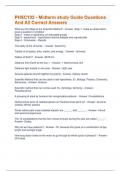
-
PHSC102 - Midterm study Guide Questions And All Correct Answers
- Exam (elaborations) • 8 pages • 2024
-
- $8.99
- + learn more
PHSC102 - Midterm study Guide Questions And All Correct Answers What are the Steps to the Scientific Method? - Answer -Step 1- make an observation, pose a question or problem Step 2 - make a hypothesis (an educated guess) Step 3 - experiment - hypothesis must be testable and reproducible Step 4 - Conclusion - Results The study of the Universe. - Answer -Astonomy Totality of all space, time, matter, and energy. - Answer -Universe Radius of Earth? - Answer -6378 Km Distance from ...
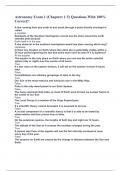
-
Astronomy Exam 1 (Chapters 1-5) Questions With 100% Correct!!
- Exam (elaborations) • 7 pages • 2023
-
- $10.99
- + learn more
Astronomy Exam 1 (Chapters 1-5) Questions With 100% Correct!! A line running from due north to due south through a point directly overhead is called a meridian Residents of the Southern Hemisphere cannot see the stars around the north celestial pole because Earth itself is in the way. A sky observer in the southern hemisphere would see stars moving which way? clockwise Is there any location on Earth where the entire sky is potentially visible within a 24 hour period (ignoring the fact t...

How did he do that? By selling his study resources on Stuvia. Try it yourself! Discover all about earning on Stuvia


